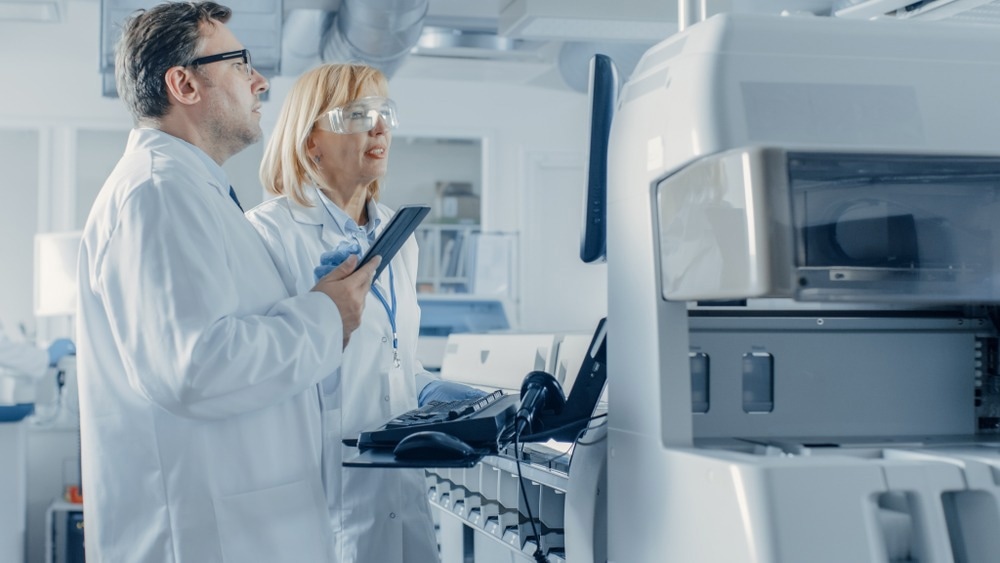In a paper recently released in the journal ACS Applied Energy Materials, researchers altered ionogel solid-electrolytes for complex electrochemical systems.

Study: Modifying Ionogel Solid-Electrolytes for Complex Electrochemical Systems. Image Credit: Gorodenkoff/Shutterstock.com
Ionogels (IGs) are a subclass of solid electrolytes that can be processed as a liquid to ensure the creation of a consistent electrode/electrolyte interface with low resistance throughout a cast electrode. These systems are made of an ionic liquid electrolyte (ILE) which is trapped within a solid nanoporous matrix and demonstrates the dimensional and mechanical stability of the matrix material at macroscales while functioning similarly to a trapped liquid at the nanoscale.
These structures are often produced by preparing a homogenous solution of matrix and electrolyte precursors, such as dissolved polymers or inorganic sols created from alkoxide.
About the Study
In the present study, researchers replaced the ionic liquid that is trapped inside a nanoporous matrix with a different liquid electrolyte to demonstrate the interfacial and physicochemical properties of solid-state Li-ion batteries (SSLBs).
A multi-step procedure was used to create gels with exchanged solvents derived from an IG based on silica. First, IGs were drop-cast in bulk molds for examination or spun on LiFePO4(LFP)-cast electrodes to a thickness of about 10 m, both of which were modifications of previously reported processes. Before being dried to get rid of any remaining water or alcohol from the sol-gel process, the IG was left to mature for the entire night. The electrodes were then submerged for two hours or more in the presence of excess parent electrolyte during a multi-step process to effect the exchange.
The physicochemical characteristics of the bulk gels post-exchange and that of the neat liquid electrolyte and base IG were compared to ascertain the degree of solvent exchange. Thermal gravimetric analysis (TGA) of the base electrolyte and exchanged gels was carried out to verify that the exchange was finished. The bulk gels were super-critically dried to prevent the silica skeleton from collapsing, and then porosity was examined using N2 gas adsorption to see whether the exchange had an effect on the matrix structure. It was compared to the electrochemical performance associated with LFP/Li metal cells containing the different gels as well as to the comparable liquid systems.
Observations
Raman analysis showed that all peaks related to the bis(trifluoromethylsulfonyl)imide (TFSI) anion in the exchange gels disappear, indicating that the assessed ionic liquid was properly replaced in the structure of the silica. At about 850 cm-1, a peak connected to the opening of the 1,3 dioxolane (DOL) ring was found to be associated with the ether system. The predicted signature for each exchanged lithium salt and solvent can be attributed to other peaks noted in the DOL, dimethyl ether (DME), and propylene carbonate (PC) spectra.
The gas isotherms' Brunauer-Emmett-Teller (BET) analysis showed that the swapped gels retained a significant surface area of a minimum of 700 m2 g-1. Since gelation is finished before the exchange, the original gel's pore distribution was maintained by the exchanged matrix. The difference in the surface area observed between the swapped gels and IG was most likely the result of pore collapse accounted for by insufficient solvent removal when drying. Estimating the ionic conductivity associated with a variety of systems showed the existence of comparable activation energies and conductivities between the gel-based and free electrolyte systems.
High cycle stability was observed for the three electrolytes assessed when compared to liquid electrolyte cells. The PC electrolyte had the highest rate capability because the ILE and DOL/DME electrolytes had lower lithium transference numbers and/or greater viscosities, which impede ion conduction and reduce system conductivity. Poorer columbic efficiency was observed in the case of the ILE cell at lower currents than for cells using other electrolytes. This was possibly due to the instability of ILE with lithium.
There was a noticeable decline in rate capability for the IG. This most likely resulted from the interaction of the ionic liquid with charged species present on the silica wall, which effectively made the pore smaller for Li+ transport. Though there was a significant decline in cycle stability observed at 1 C that was not present in the liquid systems, results comparable to those of the liquid were noted for the DOL/DME system.
The electrolytic and charge-transfer resistance significantly declined with temperature, allowing for steady capacities above 160 mA h g-1 at 1 C, which was six times the performance at room temperature. Additionally, IG usage increased the cell's columbic efficiency when compared to a liquid cell at 100 °C, perhaps by reducing unfavorable reactions incident at the lithium anode. Ionic liquids can cycle to high temperatures, but because they tend to solidify at temperatures around 0 °C, they are unsuitable with many low-temperature applications.
Overall, the study demonstrated the ability to easily modify a solution-processable solid electrolyte to perform effectively in high-power applications using a carbonate electrolyte, high-temperature applications using the base ILE, and low-temperature applications using a DOL/DME.
More from AZoM: Strong and Heat-Resistant Synthetic Fiber Kevlar and its Composites
Disclaimer: The views expressed here are those of the author expressed in their private capacity and do not necessarily represent the views of AZoM.com Limited T/A AZoNetwork the owner and operator of this website. This disclaimer forms part of the Terms and conditions of use of this website.
Source:
Ashby, D., Cardenas, J., Bhandarkar, A., Cook, A., Talin, A., Modifying Ionogel Solid-Electrolytes for Complex Electrochemical Systems, ACS Applied Energy Materials, DOI: https://www.doi.org/10.1021/acsaem.2c02085